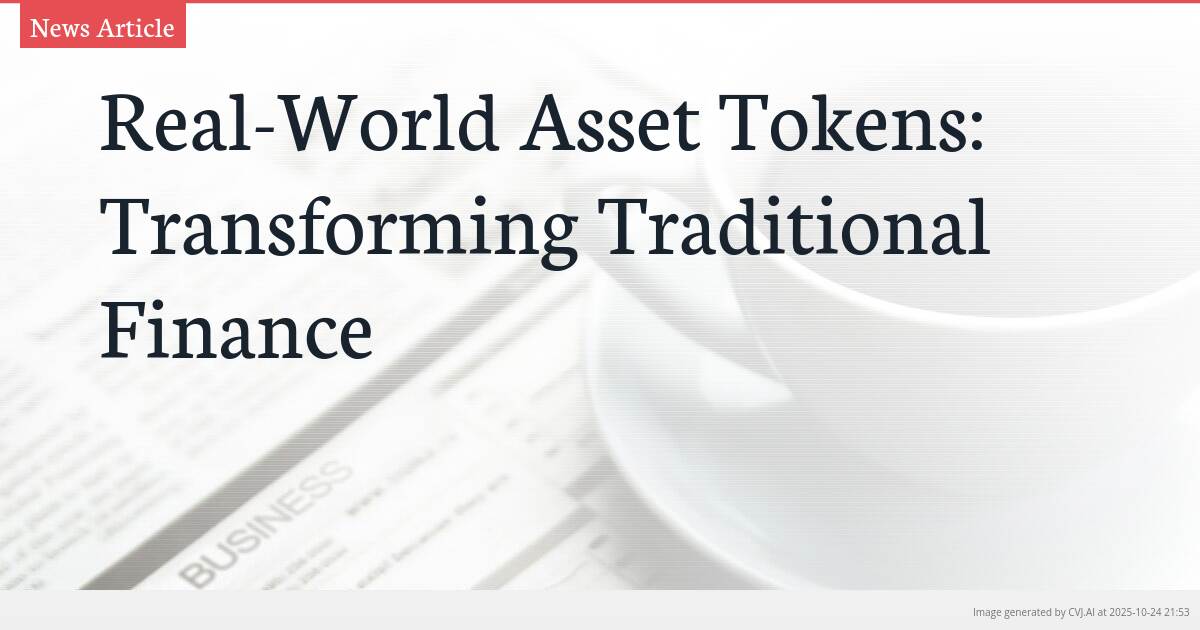This summary text is fully AI-generated and may therefore contain errors or be incomplete.
Introduction
Blockchain technology is revolutionizing traditional finance through real-world asset tokenization, creating digital representations of physical assets that are making high-value investments accessible to a broader audience. This innovation bridges the gap between traditional and digital economies by transforming how we own, trade, and manage everything from real estate to fine art through blockchain networks.
Key Points
- Tokenization enables physical assets to be divided into digital tokens that can be traded 24/7 on blockchain platforms
- The process involves strict verification of asset ownership and authenticity before creating blockchain-based smart contracts
- Major applications span real estate, fine art, commodities, and company equity, making previously illiquid markets more accessible
The Tokenization Revolution
Blockchain technology has evolved far beyond its original cryptocurrency foundations like Bitcoin, with real-world asset tokens emerging as one of its most transformative applications. These digital tokens represent ownership of physical assets including real estate, fine art, commodities, company shares, and rare collectibles. By converting tangible assets into digital tokens on blockchain networks, previously illiquid and inaccessible markets are opening to a global pool of investors.
The tokenization process begins with rigorous asset verification, ensuring legal ownership and authenticity through comprehensive documentation and compliance checks. Once verified, smart contracts on blockchain networks define the rules governing ownership and transfer of these digital tokens. The final step creates digital tokens representing fractional ownership rights, with each token corresponding to a specific portion of the underlying physical asset.
Unlocking Financial Advantages
The advantages of real-world asset tokens are reshaping investment paradigms across multiple dimensions. Enhanced liquidity stands as a primary benefit, with tokenized assets trading 24/7 compared to traditional markets with limited operating hours. This continuous trading capability transforms traditionally illiquid assets like real estate into more flexible investment vehicles.
Fractional ownership represents another revolutionary aspect, allowing investors to purchase small fractions of high-value assets that were previously inaccessible to all but the wealthiest individuals. The blockchain’s transparent and immutable ledger provides unprecedented visibility into ownership history and transaction records, significantly reducing fraud risks while ensuring legitimate asset ownership.
Global accessibility completes this trifecta of benefits, enabling investors worldwide to participate in asset markets that were once geographically constrained. This democratization of investment opportunities aligns with broader financial inclusion trends while creating more efficient, transparent markets for physical assets.
Transforming Industry Applications
Real estate tokenization represents one of the most promising applications, allowing property investors to diversify their portfolios without the capital requirements of whole-property ownership. By dividing properties into tradable tokens, real estate becomes more liquid and accessible to smaller investors while maintaining connection to tangible underlying assets.
The art and collectibles market is undergoing similar transformation, with rare artworks and valuable collectibles being divided into tokens that enable broader participation from art enthusiasts and investors. Commodities including precious metals and agricultural products are also being tokenized, creating new trading and investment opportunities in markets that have traditionally required significant infrastructure.
Early-stage companies and startups are leveraging tokenization to offer equity shares to a broader investor base, bypassing traditional funding limitations while maintaining regulatory compliance. This application demonstrates how blockchain technology and real-world asset tokens are creating synergies between traditional finance and emerging digital economies.
Navigating the Evolving Landscape
As this technology advances, regulatory considerations remain crucial for widespread adoption. The tokenization of real-world assets operates within existing financial regulations while pushing the boundaries of traditional compliance frameworks. Unlike purely digital cryptocurrencies like Bitcoin, real-world asset tokens maintain direct connections to tangible assets, providing inherent value stability compared to more volatile digital currencies.
The market for tokenized assets continues to evolve alongside broader blockchain developments, including platforms like SUI that are expanding the technological capabilities available to developers and investors. While the space faces challenges, including the recent delisting of USDT in Europe as MiCA regulations take effect and high-profile cases like Sam Bankman-Fried’s legal troubles, the fundamental value proposition of real-world asset tokens remains strong.
Trading occurs on specialized online platforms that facilitate the purchase and transfer of these digital assets, creating new market infrastructure to support this emerging asset class. As blockchain technology matures and regulatory frameworks clarify, real-world asset tokens are positioned to fundamentally reshape how we conceptualize ownership, investment, and value transfer in the digital age.
📎 Read the original article on coincodecap.com

